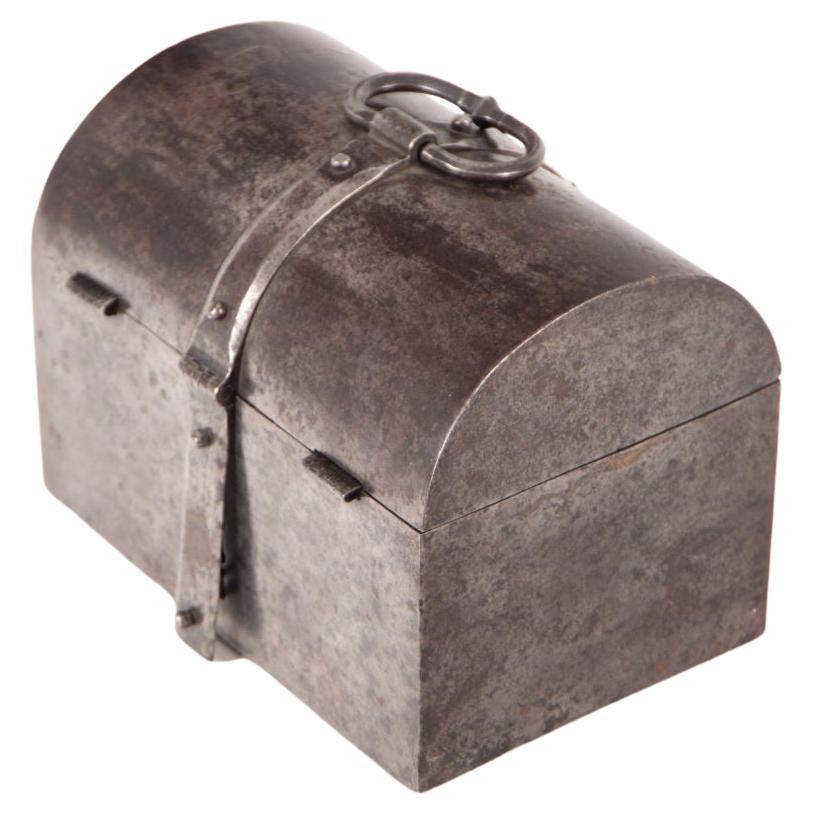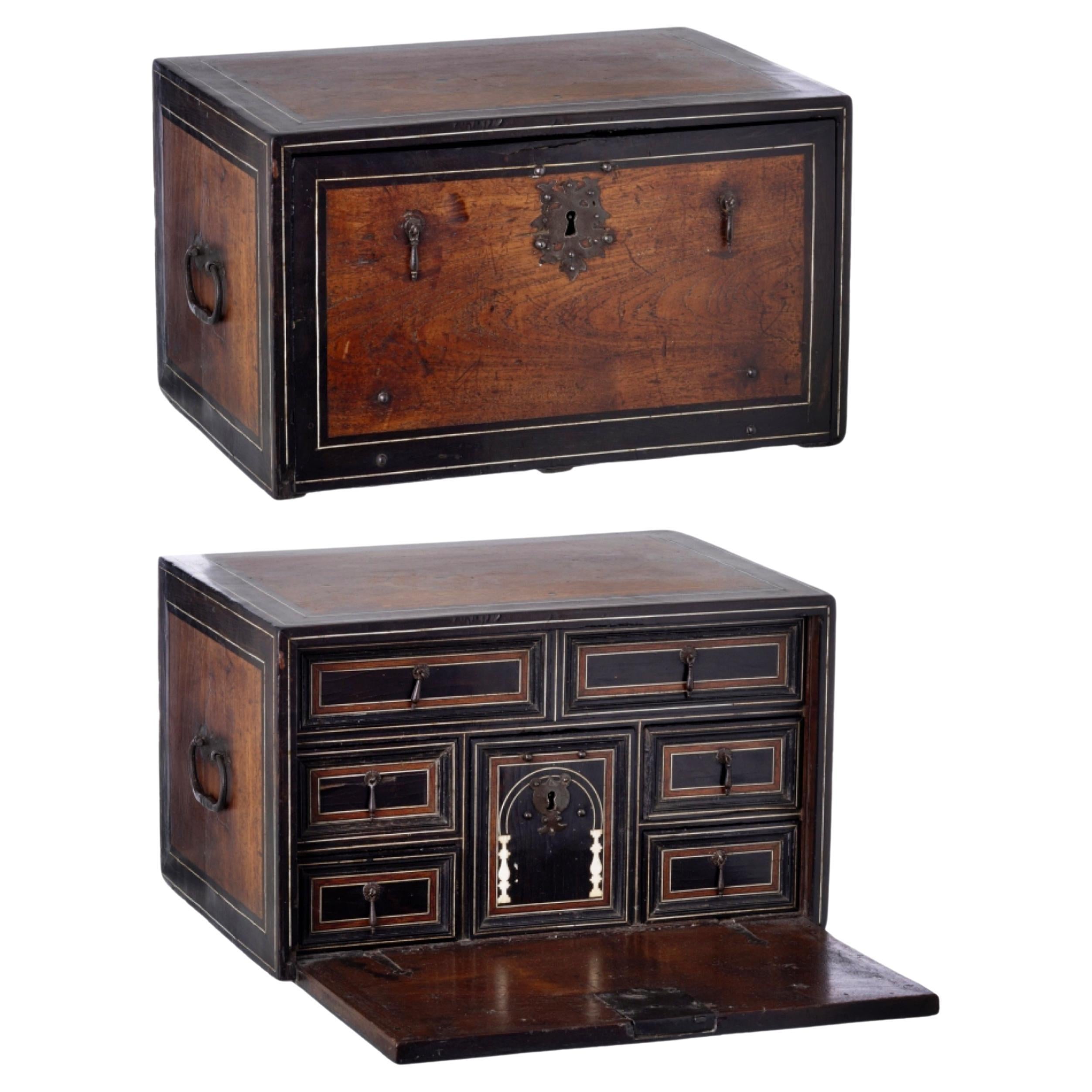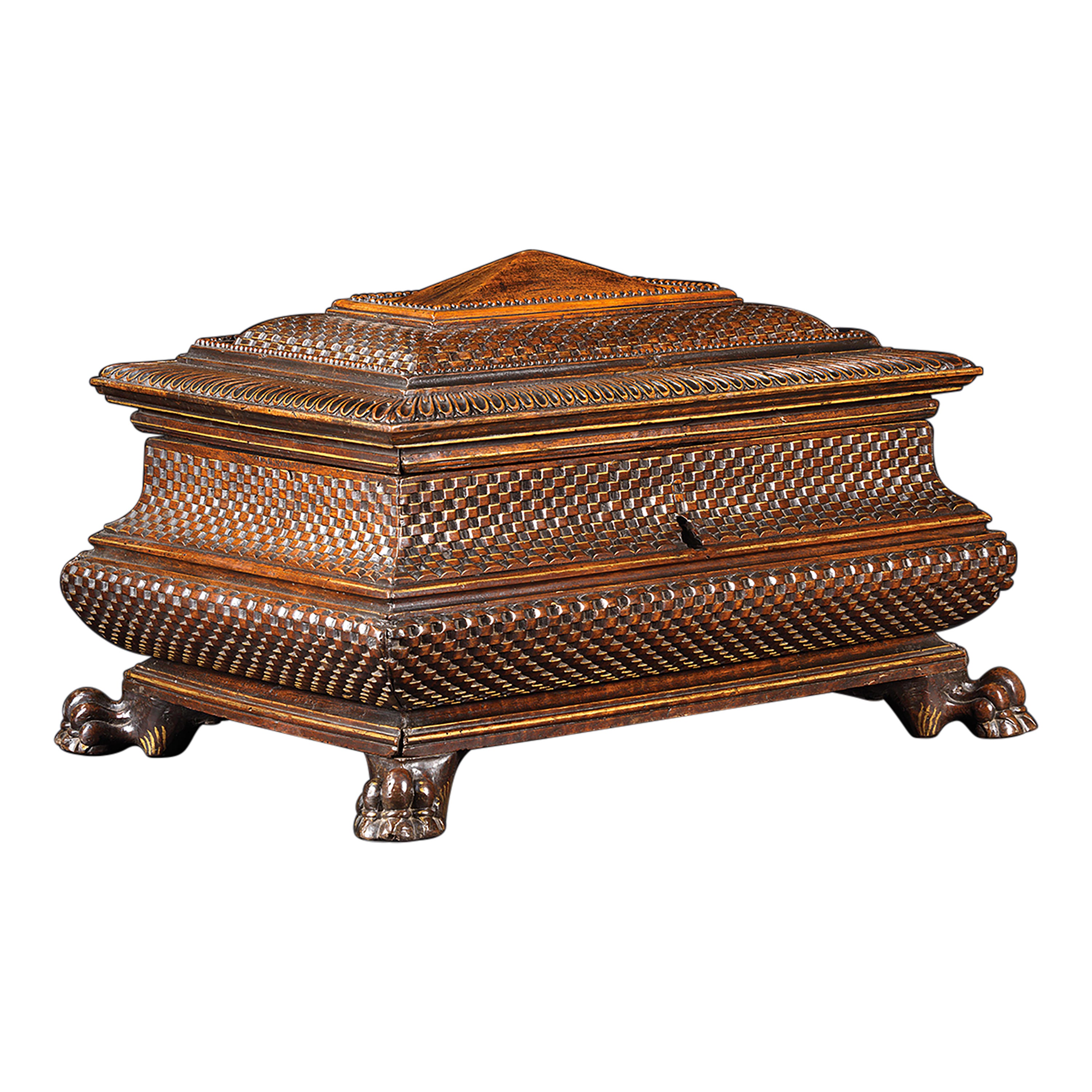Items Similar to RARE PORTUGUESE CENTER CHAPEL COUNTER 16th Century
Want more images or videos?
Request additional images or videos from the seller
1 of 11
RARE PORTUGUESE CENTER CHAPEL COUNTER 16th Century
About the Item
RARE CENTER CHAPEL COUNTER 16th Century
Lusíada - Portuguese in teak,
Partial sissoo coating with ivory inlays, with 9 drawers simulating 10.
Micromosaic in different materials, back with partial sissoo coating with ivory fillets "Islamic arches and frames", engraved silver hardware and handles in gilded bronze, of Mughal influence.
Bronze key with faceted rock crystal application.
Dim.: 56 x 41 x 27 cm
good conditions
- Creator:Europa Antiques (Cabinetmaker)
- Dimensions:Height: 22.45 in (57 cm)Width: 16.15 in (41 cm)Depth: 10.63 in (27 cm)
- Style:Gothic (Of the Period)
- Materials and Techniques:
- Place of Origin:
- Period:
- Date of Manufacture:16th century
- Condition:Wear consistent with age and use. very good condition.
- Seller Location:Madrid, ES
- Reference Number:1stDibs: LU5779236575892
About the Seller
4.9
Platinum Seller
These expertly vetted sellers are 1stDibs' most experienced sellers and are rated highest by our customers.
Established in 2005
1stDibs seller since 2021
222 sales on 1stDibs
Typical response time: 1 hour
- ShippingRetrieving quote...Ships From: Madrid, Spain
- Return PolicyA return for this item may be initiated within 14 days of delivery.
More From This SellerView All
- Rare 16th Century Nuremberg BoxBy Europa AntiquesLocated in Madrid, ESRare 16th century Nuremberg box In iron, measurements: 13 x 18 x 12 cm Good condition.Category
Antique 16th Century German Baroque Jewelry Boxes
MaterialsIron
- COUNTER CASH Indo-Portuguese from the 17th centuryBy Europa AntiquesLocated in Madrid, ESCOUNTER CASH Indo-Portuguese from the 17th century in ebony rosewood and ivory. Top, sides and front decorated with ivory inlay. Folding top showing factory with six drawers and ...Category
Antique 17th Century Portuguese Renaissance Decorative Boxes
MaterialsEbony
- Spanish Renaissance Casket of the 16th CenturyBy Europa AntiquesLocated in Madrid, ESSpanish Renaissance casket, 16th century In carved, polychrome and gilded wood decorated with a vase with horns of plenty, heads of cherubs and fruits. In the lock a shield with two ...Category
Antique 16th Century Dutch Baroque Decorative Boxes
MaterialsWood
- Amazing Chest, Italy, late 16th centuryBy Europa AntiquesLocated in Madrid, ESAmazing Chest, Italy, late 16th century 93 x 214 x 74 cm Rectangular shaped chest, in walnut wood. Four bracket feet, with four corners with sculpted leaves. Table top with owl's bea...Category
Antique 16th Century Italian Gothic Blanket Chests
MaterialsWood
- COUNTER CASH 17th Century FlemishBy Europa AntiquesLocated in Madrid, ESCOUNTER CASH 17th Century Flemish in walnut wood with inlays, consisting of two drawers and a drawer. Signs of use. Dim.: 31.5 x 44 x 27 cm good stateCategory
Antique 17th Century Dutch Baroque Decorative Boxes
MaterialsWood
- IMPORTANT TRIPTIC FLORENTINE SCHOOL (Italy) 16th CenturyBy Europa AntiquesLocated in Madrid, ESIMPORTANT TRIPTIC FLORENTINE SCHOOL (Italy) 16th Century Oil on wood, representing the Eternal Father, Our Lady with Baby Jesus, Saint Bernadino of Siena, San León, Saint Stephen an...Category
Antique 16th Century Italian Gothic Paintings
MaterialsPaint
You May Also Like
- 16th-Century Indo-Portuguese Colonial Mother-of-pearl Gujarat CasketLocated in Amsterdam, NLAn exceptional Indo-Portuguese colonial mother-of-pearl veneered casket with silver mounts India, Gujarat, 2nd half of the 16th century, the silver mounts Goa or probably Lisbon Measures: H. 16 x W. 24.6 x D. 16.1 cm An exceptional Gujarati casket with a rectangular box and truncated pyramidal lid (with slopes on each side and a flat top) made from exotic wood, probably teak (Tectona grandis), covered with a mother-of-pearl mosaic. The tesserae, cut from the shell of the green turban sea snail (Turbo marmoratus, a marine gastropod) in the shape of fish scales, are pinned to the wooden structure with silver ball-headed nails. The casket is set on bracket feet on the corners. The masterfully engraved decoration of the silver mounts follows the most refined and erudite Mannerist repertoire of rinceaux and ferroneries dating from the mid-16th century. The high quality and refinement of the silver mounts and, likewise, the silver nails that replaced the original brass pins used to hold the mother-of-pearl tesserae in place indicate the work of a silversmith probably working in Lisbon in the second half of the 16th century. The Indian origin of this production, namely from Cambay (Khambhat) and Surat in the present state of Gujarat in north India, is, as for the last three decades, consensual and fully demonstrated, not only by documentary and literary evidence - such as descriptions, travelogues and contemporary archival documentation - but also by the survival in situ of 16th-century wooden structures covered in mother-of-pearl tesserae. A fine example is a canopy decorating the tomb (dargah) of the Sufi saint, Sheik Salim Chisti (1478-1572) in Fatehpur Sikri in Agra district in the state of Uttar Pradesh, north India. This is an artistic production, geometric in character and Islamic in nature, where usually the mother-of-pearl tesserae form complex designs of fish scales or, similar to the dishes also made using the same technique, with the thin brass sheets and pins, stylized lotus flowers. The truncated pyramidal shape corresponds, like their contemporary tortoiseshell counterparts also made in Gujarat, to a piece of furniture used in the Indian subcontinent within the Islamic world prior to the arrival of the first Portuguese. This shape, in fact, is very old and peculiar to East-Asian caskets, chests or boxes used to contain and protect Buddhist texts, the sutras. A similar chest is the famous and large reliquary chest from Lisbon cathedral that once contained the relics of the city's patron saint, Saint Vincent. Both match in shape, having the same kind of socle or pedestal and bracket feet, and in their engraved silver mountings, featuring the same type of refined, erudite decoration. Their differences lie in the silver borders that frame the entire length of the edges of the chest (both the box and the lid), pinned with silver nails, and on the lock plate, shaped like a coat of arms in the Lisbon example. Given the exceptional dimensions of the reliquary casket...Category
Antique 16th Century Indian Jewelry Boxes
MaterialsSilver
- Late 16th Century Jewelry ChestLocated in Saint-Ouen, FRProvenance : Jean Gismondi collection, before 1973. This important walnut jewelry chest is outlined with a gilt motif and presents a decor imitating basketry. The lid is topped by...Category
Antique 16th Century Italian Renaissance Jewelry Boxes
MaterialsWalnut
- 16th Century Bronze and Gilded Copper BoxLocated in Brescia, ITBronze and gilded copper box, Central Europe, 16th century Dimensions: 13 x 17.2 x 12.2 cm Resting on the ground by means of four spherical feet in...Category
Antique 16th Century Dutch Renaissance Decorative Boxes
MaterialsBronze, Copper
- Large Japanese Namban Lacquer Coffer Arqueta, 16th CenturyLocated in Amsterdam, NLA large Japanese Namban lacquer arqueta coffer for the Portuguese market Kyoto, Momoyama-period, late 16th century In Hinoki cypress lacquered in ...Category
Antique 16th Century Japanese Decorative Boxes
MaterialsMother-of-Pearl, Wood
- A 16th/17th Century Style French Red Lacquered Small ChestLocated in Sheffield, MAAn Early & Rare French Red Lacquered
Leather Bound Wood & Iron Small Chest
Height 15 in. Depth 9 in. Width 13 in. ...CategoryAntique 18th Century and Earlier French Boxes
- Pyx. Carved and Polychrome Wood, Spanish School, 16th CenturyLocated in Madrid, ESPyx. Carved and polychrome wood. Spanish school, 16th century. Box with a circular base and a frustoconical body that has a vaulted lid topped with a knob with a molding, it is made of carved wood and preserves traces of gilding on its outer surface and also on the interior (lid and base). In this area it is decorated with some vegetable-themed carvings on the lid and winged angel heads joined by curved textiles reminiscent of garlands on the front of the body. Typologically, the shape of the piece is reminiscent of silver pyxes...Category
Antique 16th Century Spanish Renaissance Religious Items
MaterialsOther
Recently Viewed
View AllMore Ways To Browse
Antique Bronze Silver Box
Antique Gilded Bronze Box
Antique Portuguese Counter
Egypt Mother Of Pearls Box
18th Century French Bread Box
Small Antique Leather Boxes
19th Ink Well And Box
Emaille Table
Fountain Alhambra
General Store Coffee Tin
Limoges Dog
Pigskin Box
Vintage Brass Powder Flasks
Antique Oak Stationery Box
Boulle Box Glove
Cat Teapot Vintage
Coromandel Stationary Box
Easter Candy Container





